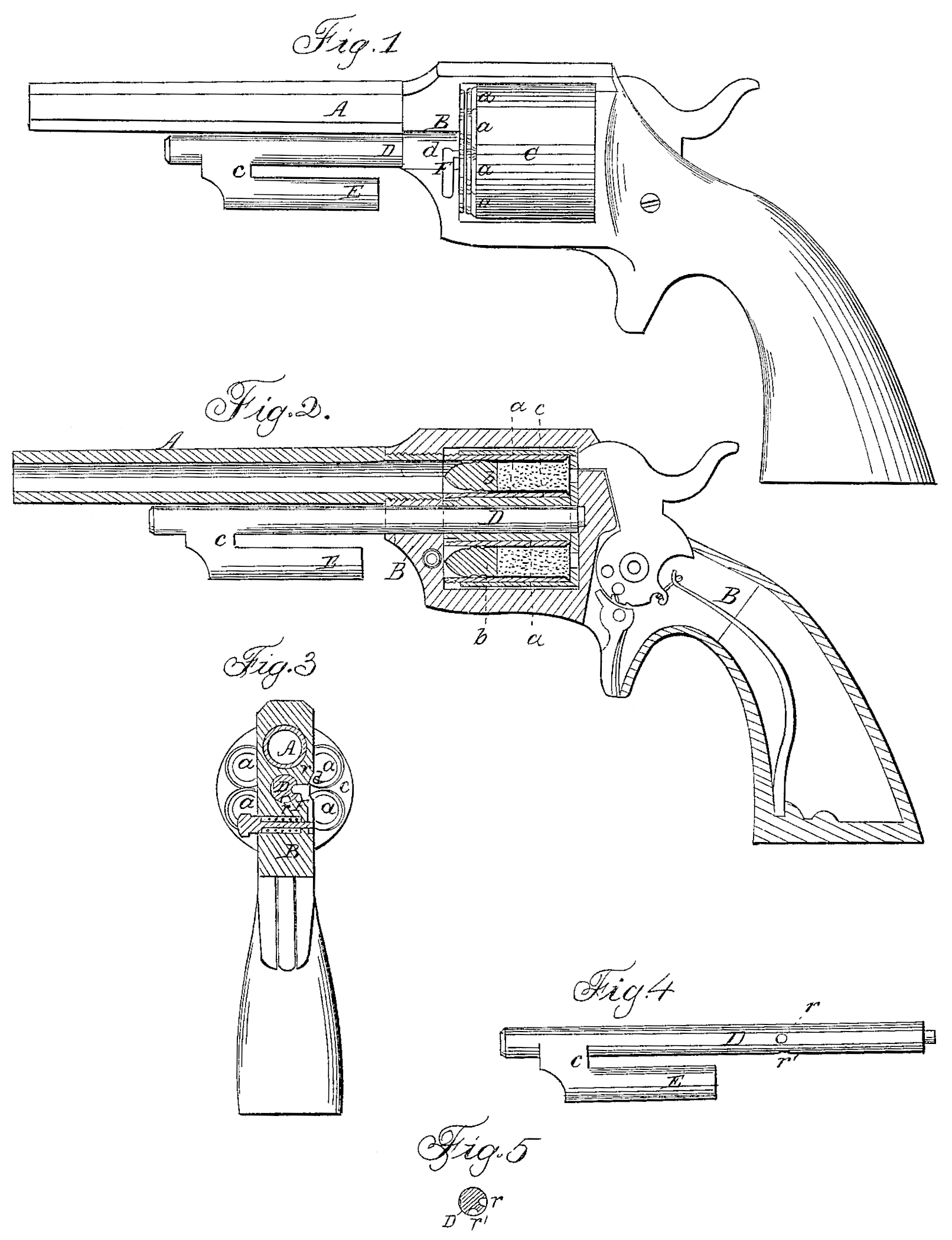US 44953
UNITED STATES PATENT OFFICE.
FREEMAN W. HOOD, OF WORCESTER, MASSACHUSETTS.
IMPROVEMENT IN REVOLVING FIRE-ARMS.
Specification forming part of Letters Patent No. 44953, dated November 8, 1864.
To all whom it may concern:
Be it known that I, Freeman W. Hood, of the city and county of Worcester, and State of Massachusetts, have made an invention having reference to Fire-Arms or Revolvers; and I do hereby declare the same to be fully described in the following specification and resented in the accompanying drawings, of which—
Figure 1 is a side elevation, and Fig. 2 a. longitudinal section, of a revolver-pistol as provided With my invention. Fig. 3 is a transverse section taken through the spindle-latching mechanism, to be hereinafter explained. Fig. 4 is a side view of the spindle and the discharger as separated from the rest of the pistol. Fig. 5 is a transverse section of the latching notch or recess of the spindle.
My invention specially belongs to that class of revolvers which have not only a series of detachable cartridge-carriers or receiving cells or tubes inserted within the rotary breech or magazine and for holding a series of cartridges, but are provided with a rammer or dicharger for expelling from either of the cartridge-receiving tubes the exploded shell or remains of a discharged cartridge, the mode of effecting the expulsion of such shell from its tube being by drawing the tube out of the rotary breech or magazine and upon the rammer or discharger, so as to cause the latter to pass into the tube and force the shell from it. The United States Patent No. 39,869, granted to John H. Wickers and Lucius W. Pond, exhibits an invention of this character, and it is to such that my improvement relates, the nature of my invention consisting in the application of the shell-discharger to the center-pin or spindle of the rotary magazine or breech, so as to be movable therewith, and for the purpose or purposes as hereinafter explained; and, furthermore, my invention includes the combination and arrangement of a peculiar latching mechanism with the spindle, the discharger, and the series of cartridge-tubes, combined together and with the barrel and the rotary magazine, as here in after specified.
In the drawings, A denotes the barrel, B the stock, and C the rotary magazine or breech, of a revolver-pistol, each chamber of the said magazine being provided with a detachable tube, a, for receiving a cartridge, b, in manner as represented in Fig. 2. This magazine is supported by and so as to be capable of being revolved on a spindle, D, which extends into and beyond the stock and parallel with and below the barrel, in manner as shown in Figs. 1 and 2.
The cartridge-shell discharger is represented at E as arranged parallel to the spindle and connected to it by a projection, c, the whole being as shown in Figs. 1, 2, and 4, the axis of the discharger being at a distance from that of the pin which is equal to the distance of such axis of the pin from the axis of either of the detachable tubes a.
There is a spring-latch, F, applied to the stock, and constructed and arranged with respect to the rotary magazine in manner as shown in Figs. 1 and 3. This latch operates with two catch-recesses, r r’, formed in the spindle, in manner as shown in Figs. 4 and 5. When the three axes of the barrel, the spindle, and the discharger are in one plane, the spring-latch not only will lock the discharger in its position, but so project beyond the surface of the side of the stock as to effectually prevent from falling out of the magazine that tube a which may be in range of the groove d, which is made in the stock, and through which the tube is drawn during the act of extracting it from the magazine when the latter is in place on the spindle. Furthermore, the latch and its recess, constituting the latching mechanism, perform the functions of keeping the spindle in its place in the stock and also of holding the spindle in its proper position for the discharger to receive a tube a while such tube may be in the act of being drawn out of the magazine. In order to bring the discharger into its proper position to enter each tube, the spindle should be revolved axially through an arc of ninety degrees. The duty of the discharger is not only to receive and support the tube, but to expel from it a waste cartridge or exploded case of a cartridge, which, on the tube being drawn upon the discharger, will be forced out of the tube.
The recess r’ should be so formed or be of such depth as to cause the latch, while a tube may be in the act of being withdrawn from the magazine, to be out of the way of or present no impediment to the tube.
I do not claim the combination of an attached rod or cartridge-shell discharger with a revolver provided with a series of separate cartridge cases or tubes inserted within the rotary breech or magazine, in manner and for the purpose set forth.
I claim as my invention—
1. The application of the waste cartridge or shell discharger E to the spindle D of the magazine, substantially in manner and so as to operate there with, as described.
2. In combination with the spindle D, the discharger E, and the series of detachable cartridge tubes or carriers a a a a, combined together and with the barrel and the rotary magazine, as set forth, the latching mechanism so arranged as to serve the double purpose of retaining the cartridge-cases and locking the spindle, substantially as explained and represented.
FREEMAN W. HOOD.
Witnesses:
P. C. Bacon,
F. J. Barnard.

